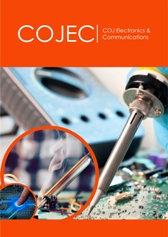- Submissions
Abstract
COJ Electronics & Communications
Two Purpose-Oriented RIS-Aided Schemes to Enhance and Evaluate the Performance of Wireless Communication
-
Open or CloseAli H Wheeb1*, Fahimuddin Shaik2 and Shaik Karimullah2
1Department of Aeronautical Engineering, College of Engineering, University of Baghdad, Iraq
2Annamacharya Institute of Technology and Sciences, India
*Corresponding author:Ali H Wheeb, Department of Aeronautical Engineering, College of Engineering, University of Baghdad, Iraq
Submission: October 10, 2024;Published: October 18, 2024

ISSN: 2577-2007Volume3 Issue1
Abstract
Intelligent Reflecting Surface-IRS or Reconfigurable intelligent surface-RIS is a transmission technology that can enhance the performance of wireless communication systems by reflecting electromagnetic signals in a specific direction. The question is which RIS-aided scheme is the most appropriate for a given wireless communication scenario, considering performance factors such as energy efficiency and transmit power. In the literature, two oriented RIS-aided schemes are usually determined: The Exhaustive RIS-Aided (ERA) scheme and the Opportunistic RIS-Aided (ORA) scheme. Both schemes have been considered for evaluating the performance of wireless communication. This paper presents a methodology and analysis of RIS technology for wireless communication systems. It presents a mathematical model to optimize the reflected signal’s phase shift and evaluates the system’s performance using numerical simulations. Moreover, it proposes two algorithms for implementing the ERA and ORA schemes. It analyzes the ERA and ORA methods transmit power schemes to determine their energy efficiency. The analysis of the experimental investigations shows that the ORA scheme has sophisticated transmit power values and attains maximum energy efficiency by using less energy compared to the ERA scheme. ORA is superior to ERA in terms of energy and efficiency.
Keywords: Reconfigurable intelligent surface (RIS); RIS-aided schemes; Performance evaluation; Wireless communication; Transmit power; Energy efficiency
Abbreviations: AI: Artificial Intelligence; AP: Access Point; BS: Base Station, CS: Compressive Sensing (theory); CSI: Channel State Information; ERA: Exhaustive RIS-Aided (scheme); IoT: Internet of Things; IRS: Intelligent Reflecting Surface; MISO: Multiple-Input and Single-Output; MMSE: Minimum Mean Square Error (estimation); ORA: Opportunistic RIS-Aided (scheme); QoS: Quality of Service; RIS: Reconfigurable Intelligent Surface; RL: Reinforcement Learning; SNR: Signal-to-Noise Ratio, UAV: Unmanned Aerial Vehicle; 5G: 5th Generation; 6G: 6th Generation
 a Creative Commons Attribution 4.0 International License. Based on a work at www.crimsonpublishers.com.
Best viewed in
a Creative Commons Attribution 4.0 International License. Based on a work at www.crimsonpublishers.com.
Best viewed in 







.jpg)






























 Editorial Board Registrations
Editorial Board Registrations Submit your Article
Submit your Article Refer a Friend
Refer a Friend Advertise With Us
Advertise With Us
.jpg)






.jpg)














.bmp)
.jpg)
.png)
.jpg)










.jpg)






.png)

.png)



.png)






